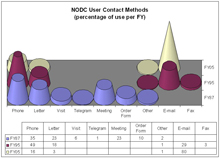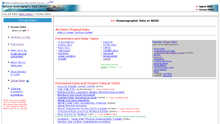Delivery of Oceanographic Data: Alive and Well in a Modern World
The National Oceanographic Data Center (NODC) holds global physical, chemical, and biological oceanographic data sets that are being used by researchers worldwide. NODC's Ocean Climate Laboratory investigates ocean-climate variability using historical oceanographic data and by building scientifically, quality-controlled global oceanographic databases in their products, which are known as the World Ocean Atlas and World Ocean Database.
A phone call comes in. A letter is received. A scientist needs data to support a research effort, a student is hoping for help with a school project, an environmental manager is searching for data that will help develop a plan.
Over the history of the National Oceanographic Data Center (NODC), the kinds of requests for data and information have not changed all that much. What has changed dramatically is how requests are received and how users obtain their data. Similarly, dramatic changes have occurred in how data is stored and how it is made available.
Contacting the NODC: Then and Now

This graph shows percentages of the methods used to contact the NODC in fiscal years (FY) 1987, 1995, and 2005. Click image for larger view and full caption.
Throughout the 1980s, a phone call or letter was the most popular way of contacting the NODC for data or information such as oxygen concentrations, salinity, or sea level. Of course, there were also telegram, telex, fax, and order form options.
Today, most people find it easier to fire off an Email than to write a letter. Email has now become the number one method for contacting the NODC. On average, the NODC will field four to five requests for information each day.
Data Availability
The real story in the transmittal of oceanographic data and information, however, is in how one actually obtains the data.
That Was Then
Back in the days before the World Wide Web and global Internet access, anyone needing data had to contact the NODC and provide specifics about what they needed (time, place, and type of data) and how they would like to receive it. Because requests were often submitted via mail, and then "orders" were fulfilled by mail, it could take six weeks or longer from when a data order was placed until the user actually received the data.
Historically, all NOAA products and services were provided for the cost of recovery. Prices were based on what it cost the government to collect, process, store, and retrieve the data. In the last six to seven years, however, there has been a concerted effort to make NOAA data freely available online.
This is Now
During the mid-1990s, seven-track and nine-track magnetic tapes gave way to 5 ¼ inch and 3 ½ inch diskettes. By the year 2000, CD-ROMs were the preferred medium for storing data. Today, DVDs are used most commonly for storing data.
Rapid developments in computers and the Internet have now placed most of NOAA oceanographic data right at the fingertips of most users. Data transfer speed, computer processing capabilities, and storage space are no longer issues.

Today, users can visit the NODC Web site and access data directly online—no waiting for the mailman to arrive with your data!
Need data? No problem! Log on, search the NODC database, and download what you need when you need it. No more waiting for the letter to get to the NODC, waiting for data to be extracted and placed on some form of output media, and then waiting beside the mailbox for the package containing your precious data to finally, finally, arrive.
Instant access is what people want and expect these days, and access to data online allows this instant gratification. An added advantage to allowing users to search and retrieve NODC data is the price. With today's "do-it-yourself" access, the bulk of NODC's data are now available at no cost.
A New Era: The World Ocean Database
One of the main forces pushing this evolution of data delivery within the NODC has been the global climatological atlas, now referred to as the World Ocean Database (WOD). In August 1993, the NODC added a new division called the Ocean Climate Laboratory (OCL).
The OCL was charged with developing improved ocean climatologies by:
- using historical data to evaluate changes over time;
- assessing and improving the quality of the available data using objective analyses; and
- augmenting the volume of data in the NODC archives.
The first World Ocean Database was produced in 1994, and built upon the 1982 Climatological Atlas of the World Ocean. The original 1982 dataset was comprised of 12 nine-track digital tapes and analyzed values for temperature, salinity, and oxygen.
Not only did the World Ocean Atlas 1994 include significantly more data and nearly three million new oceanographic data collection sites, it also added five new parameters, to include analyses for apparent oxygen utilization, oxygen saturation, phosphate, nitrate, and silicate. This 1994 dataset was distributed on nine CD-ROMs.
By 2001, the World Ocean Database was NODC's primary database, containing all of NOAA's archived and quality-controlled profile data, and including temperature, salinity, oxygen, nutrients, chlorophyll, and plankton data.
The newly released World Ocean Database 2005 contains 7.9 million stations with eight new parameters added to the suite of available data. This release fits on a single DVD—much easier than the previous 12 magnetic tapes or nine CDs required to hold the same amount of data!

This table shows growth and cost comparisons of the World Ocean Database from 1982-2005. Click image for larger view.
The World Ocean Database has become the number one source of NODC archived data for users of NOAA information. Analyzing the data for global climatologies has allowed for improved quality control and validation of the data. Not only do users now have easier access to global oceanographic data, the data are of a much higher quality. Anyone needing verified profile data can now go to the NODC Web site, use the World Ocean Database search tool to query the database, and download the data straight to their computer. Those wishing to obtain the full dataset pay a fraction of the $1320 cost of the original set of 12 magnetic tapes from 1982 for a single DVD, containing three times more data.
Conclusion
Changes in how people access and obtain NODC oceanographic data have had some obvious side effects. Programmers and Web developers can now create databases and query tools that allow users to go online and do for themselves what once required, at a minimum, a customer service representative, a programmer, a tape librarian, and a computer operator for each individual request. The number of customer contacts has been greatly reduced, as well as the staff needed to respond to customer inquiries.
Today's requested services are as likely to be from the general public as from the research community.
At the NODC, answering questions about the data is now more common than filling requests for data. Helping guide people to the data they need, answering questions about specific types of data or products, and responding to general questions and referrals are standard fare for the NODC customer service representatives. Obtaining quality-controlled oceanographic data quickly, easily, and at a reasonable price is now standard fare for NOAA's user community.
